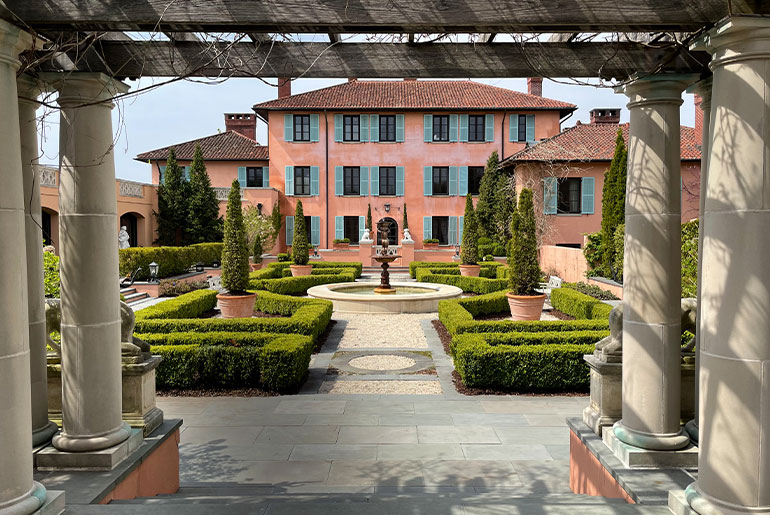“Mrs. Meir, it is good to be here at last. I have been waiting for this moment.” Those were Egyptian President Anwar’s Sadat’s first words when he stepped off the plane at Tel Aviv’s Ben-Gurion Airport in 1977 — the first time an Arab head of state had visited the Jewish state — as the former Israeli Prime Minister Golda Meir stepped forward to greet him. The redoubtable grandmother smiled at Sadat, with whose country, only four years earlier, Israel had been at war and palms turned heavenward, looking him straight in the eye, she replied, “In that case, Mr. President, I must ask you. What on earth took you so long?”
I have my own Sadat moment recently, visiting Glenmere, a Relais & Châteaux hotel in Chester, New York, for the first time. Despite a former professional attachment to the luxury Relais & Châteaux collection of hotels, I had never been to Glenmere — a 110-year-old, Gilded Age mansion relaunched as a luxury hotel in 2010 after decades in decline — even though a friend, a well-known travel writer on Robb Report, had assured me it was “probably the most luxurious small hotel in North America.” Really? I found it so unlikely. Maybe that’s why I never rushed to visit. Curiosity was never going to kill this cat.
We arrive on a sultry weekday afternoon, the first really warm day of the year, already drop-jawed at the first glimpse through the trees on the long driveway of this beautiful, honey-colored house. We circle the courtyard and Chris greets us at the front door, announcing he will be our butler. He says he will take care of our car and our bags and indeed any other things that may need to be taken care.
The Italianate mansion was built in 1911 for Robert Goelet, heir to an immense real estate fortune, who spared no expense on his extravaganza, where he would entertain royalty, heads of state, celebrities of the age, you name ’em. But after 30 years he tired of it, as not only the very rich but as all of us occasionally do of the things we once loved. The house, along with what remained of the original 3,000-acre estate, was sold to developers.
The mansion became a hotel, as mansions do, and over time changed hands many times, gradually falling into disrepair. Fast forward 40 years and the current owners, the writer and ex-realtor Alan Stenberg, and his partner, the orthopedic surgeon Daniel DeSimone, M.D., were driving to Hastings-on-Hudson one day when they caught sight of the house and decided they had to have it, an incredibly reckless thing to do. They spent four years and $40 million dollars restoring it. But, of course, you don’t just throw money at such “vanity” hotel projects if they are to succeed. You work all the hours God sends and then somehow find a few more and you offer up blood, sweat and tears, as well as applying shedloads of good taste and your own experience of staying in great hotels around the world, from which you have learned a thing or two.
Glenmere was designed by architects Carrère and Hastings, who also did New York’s original Frick Collection and the New York Public Library, which opened the same year as Glenmere. The gardens — notably the sunken garden between the house and the lake — were the work of America’s first woman landscape gardener, Beatrix Farrand, who spent time in England and regarded the celebrated British landscape gardener, Gertrude Jekyll, as a mentor and you feel this, an English sensibility, along with the Italian. Like the house, the gardens are a wonder, bringing to mind a Gainsborough, or an early Corot as we behold them from our corner room, looking out across manicured lawns that sweep softly down to Glenmere Lake. All the colors become muted in the distance and the haze and the entire view are seemingly suspended in time.
In the guest rooms, style reigns, but never at the expense of comfort. Indeed, they go hand in hand. The plushest Italian bed linens adorn what has to be the world’s most comfortable bed, in front of which a pair of dashing, lime green-covered silver chrome ottomans stand guard. And as if he were a family friend or relative, a photograph of Robert Goelet nestles among the bibelots and larger “pieces,” in a room which is full but exudes no sense of clutter. Still, having promised by way of a standard waiver at check-in, almost on penalty of death, not to smoke on the premises, I’m intrigued by a large china ashtray (remember those?) bearing the face of the late Emperor Hirohito, which I found on the black, faux crocodile-covered desktop. It bore a tiny sticker on the underside, which read, “for decoration purposes only.”
The marble bathroom is equally remarkable, with its free-standing bathtub, deep as a pit; an old Delft waste bin, heavy as a boulder and decorated with blue and white fishes; and an exquisite inverted-dome Maiolica wash basin, with its intense but luminous pattern, fit for a Spanish king.
Back down the grand, stone staircase, you come to the playfully conceived Frogs End bar and tavern and the sun-dappled cortile, which is the symmetrical center point, the heart of the house. Carry on and you reach the library, with its books (of course), its fireplace, outsized Scrabble table, antique backgammon boards, contemporary art and zingy fabrics. And in the stone gray and taupe drawing room that adjoins it, with its Art Deco mirrors, obelisks, Greek vases, ormolu clocks and ostrich sofas, even the logs by the fireplace are gray birch — color coordination taken to extremes. In short, where everything could all go so horribly wrong, it doesn’t. Instead, it is so utterly, deliciously right.
In the restaurant, cozily called The Supper Room, the mostly-male wait staff move with the grace and precision of a corps de ballet, plates placed and removed silently; a staff member always discreetly positioned to watch the room, so that service — should your wishes fail to have been anticipated — is never more than the merest glance away. For all this professionalism, there are no noses in the air here and no one is above making a joke or camping it up a touch, our French waiter proposing a “magnificent, marvelous, massive slice” of coconut cake for dessert, a confection he assures us that Executive Pastry Chef Taiesha Martin makes only on the rarest of occasions.
Outside, meanwhile, formal gardens and courtyards spread out from the house in geometric form, one of them leading to the spa and swimming pool. Like all the best pools, Glenmere’s is based on a simple rectangular design and, like the best Tuscan swimming pools, it boasts a loggia at the side, where it is going to be bliss to sit in summer.
And on and on you could go, praising this New York Italian jewel to the skies. But suffice it to say, bravo, Glenmere: You probably are the most luxurious small hotel in America, as my friend observed. For my part, better late than never and I’m glad I finally got here, although with a nod to the late Sadat, I’m still kicking myself that it took me so long to do so.
For reservations, visit glenmeremansion.com






